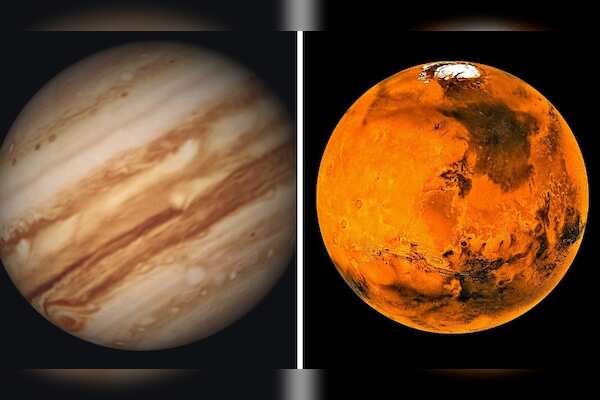Earlier this year, NASA's Juno spacecraft made an incredible discovery by spotting Jupiter's elusive fifth moon, known as Amalthea. This remarkable sighting occurred as Amalthea transited the planet's iconic Great Red Spot, providing researchers with a unique and rare perspective of this small yet captivating natural satellite. Among Jupiter's 95 known moons, Amalthea holds the position as the fifth largest, following behind the more widely recognized moons of Io, Europa, Ganymede, and Callisto.
Despite its relatively small size, Amalthea boasts dimensions of 250 kilometers in length at its longest axis and 128 kilometers at its narrowest point. Scientists describe Amalthea as resembling a potato, suggesting that it is more akin to a loosely held-together rubble pile rather than a solid rock structure. The Juno spacecraft captured a glimpse of Amalthea on March 7 during its 59th close pass by Jupiter. Initially appearing as a tiny black dot against the backdrop of Jupiter's reddish, dark cloud bands, Amalthea was later observed by Juno as it transited the Great Red Spot. The stunning contrast between the small moon and the massive storm of the Great Red Spot is truly remarkable, with Amalthea floating at a distance of 112,500 miles (181,000 km) above Jupiter's cloud tops while the storm itself spans a whopping 7,767 miles (12,500 km) in diameter. Despite its small size, Amalthea has the shortest orbital period around Jupiter, completing one full rotation every 0.5 Earth days. One of the many mysteries surrounding Amalthea is its intriguing heat emission, which appears to exceed the amount of heat it receives from the Sun. Scientists are still puzzled by the source of this additional energy, with various theories suggesting a combination of direct and indirect heat from Jupiter, as well as heat generated by tidal pressures within Amalthea due to Jupiter's gravitational pull. Amidst the shadow of its larger siblings, Amalthea often gets overlooked in scientific discussions. However, the significance of further exploration of this enigmatic natural satellite cannot be understated. Unraveling the mysteries of Amalthea will shed light on its unique characteristics and contribute to our understanding of the complex system of Jupiter's moons.Juno's Discovery: Jupiter's Fifth Moon, Amalthea, Revealed
 6 months ago
1648
6 months ago
1648
- Homepage
- Tech & Sicence
- Juno's Discovery: Jupiter's Fifth Moon, Amalthea, Revealed
Related
NASA Faces 19-Day Deadline to Bring Back Astronauts from ISS...
3 months ago
1122
Nvidia potentially delaying release of data center GPU B200 ...
3 months ago
1138
Rare Celestial Event: Mars and Jupiter Alignment on August 1...
3 months ago
1505
Trending in United States of America
Popular
Disney's Major Investment in Epic Games Signals Next Chapter...
8 months ago
1804
Top commodity trader Andurand predicts quadruple increase in...
6 months ago
1741
Middle East tension boosts Brent crude above $90 for the fir...
7 months ago
1735
World of Warcraft Companion App to be Discontinued by Blizza...
7 months ago
1731
"Don't Take Travel for Granted: Tips for Traveling with Elde...
8 months ago
1728
© StoryBrut 2024. All rights are reserved








 English (US)
English (US)